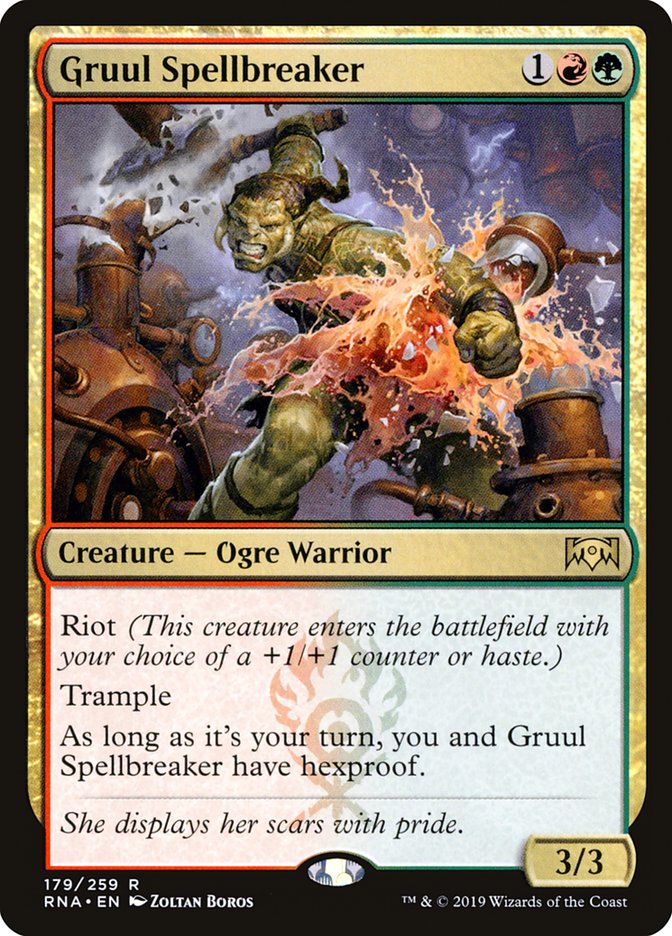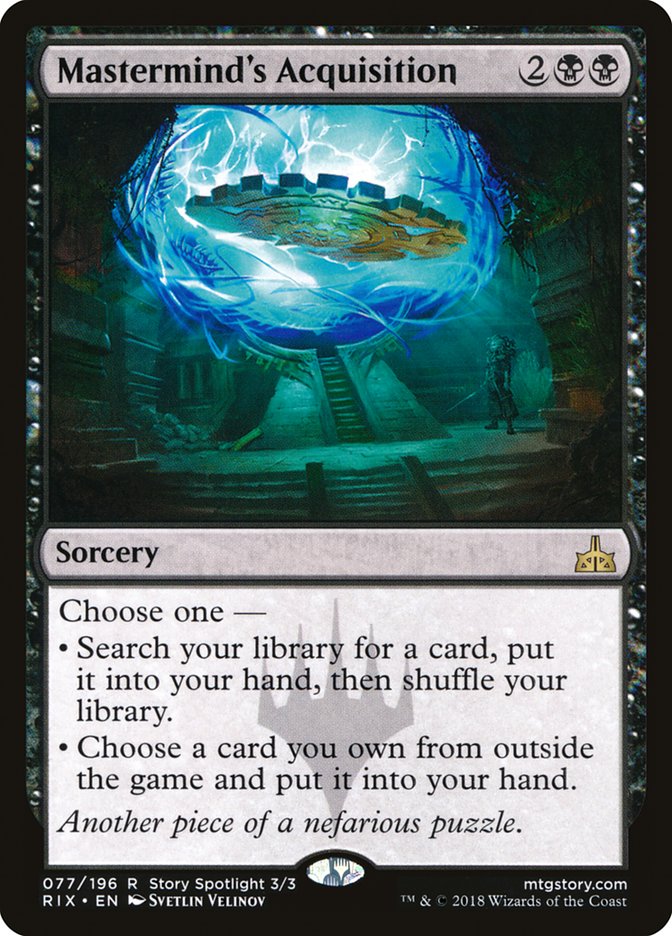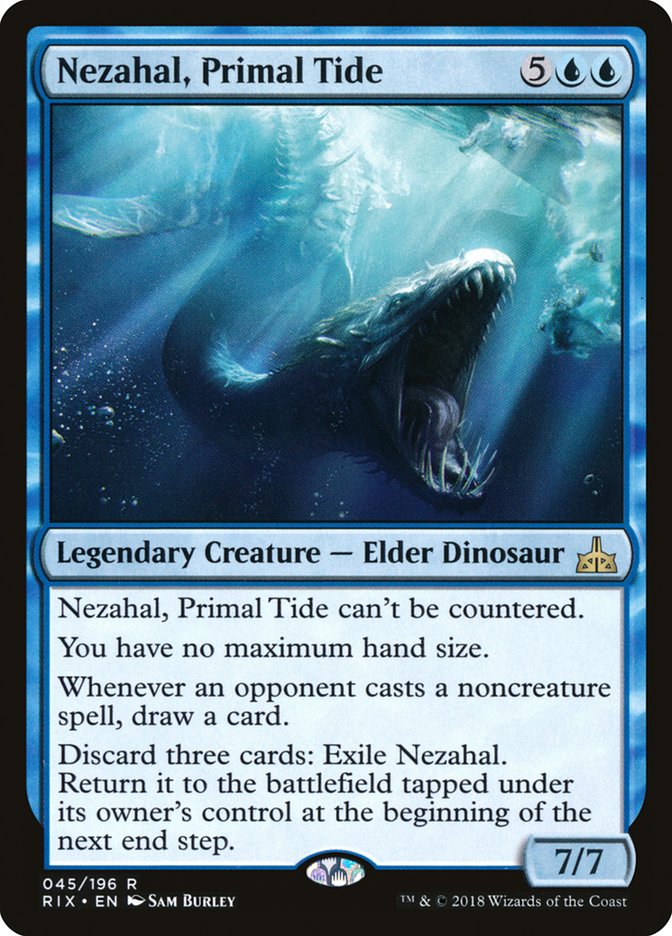I came to start my testing for the Mythic Invitational a little bit later than most. Despite wanting to give my all in to preparation for this historic event that Wizards of the Coast had invited me to, a pretty major (and positive) life occurrence had me decidedly out of action for a bit over a week. By the time I got to beginning my testing it seemed like a clear consensus had been reached among seemingly everyone on what the best Level 0 decks were; Mono-Red Aggro, Mono-White Aggro, and Esper Control. I’m not going to rehash this too much as it has been said a lot by now, but essentially these three decks maximize baseline power level whilst forcing extreme responses from opponents in order to be beaten – the sort of responses that normally enter the fray via post-sideboard games, which are notably absent from the best-of-one play that forms the basis of the Mythic Invitational’s Duo Standard format.
So by the time I finally started jamming games and working with Gabriel Nassif, my testing partner for this event, I was entering very much from the perspective of asking whether you can reasonably beat this trio of decks consistently. What sort of overlaps do you need to exploit to be advantaged against any two of these decks that focus on killing you either with burn spells, with Savannah Lions and Glorious Anthems, or without creatures and instead just point-and-click answers and pure card advantage?
Entreating the Angels
Perhaps the most obvious card to exploit an overlap in weaknesses between a pair of this trio was Lyra Dawnbringer:
Creatures (33)
- 4 Llanowar Elves
- 4 Wildgrowth Walker
- 4 Merfolk Branchwalker
- 4 Jadelight Ranger
- 3 Lyra Dawnbringer
- 3 Shalai, Voice of Plenty
- 4 Resplendent Angel
- 3 Knight of Autumn
- 4 Growth-Chamber Guardian
Planeswalkers (2)
Lands (24)
Spells (1)

This relatively stock Selesnya Angels decklist was one of the most appealing starting points for attempting to attack the format. Mono-Red is pretty capable of burning down a single Lyra, Shalai, Voice of Plenty, or Resplendent Angel, but with them working in unison, especially alongside Wildgrowth Walkers as lightning rods too, you just present too many problems for them to answer. The situation against Mono-White is less simple, at least now that Unbreakable Formation makes just having a bunch of big ol’ green creatures clogging up the ground way less of a speed-bump than it used to be. If you assemble the combo of Lyra and any-other-Angel, then winning is relatively trivial, but Selesnya Angels was not crushing in the matchup nearly as much as had been advertised to me, whilst the matchup of Wildgrowth Walker and a pile of five-drops against Kaya’s Wrath and Absorb felt predictably awful.
Gab was much more interested in Gruul Aggro and Midrange decks than I was, but we both toyed with a large amount of these decks throughout the testing process. I’m not going to post a list here because there were an awful lot of them and they were all reasonably stock and boring, but they were mostly pretty solid, boasting good Mono-Red matchups thanks in large part to three-mana 4/4s being surprisingly obnoxious for the Lightning Strike deck to deal with, whilst the Esper Control matchups were generally pretty close with haste creatures to punish Kaya’s Wrath and Dire Fleet Daredevils to punish Thought Erasures. The Mono-White matchups were just awful, though, with the various Glorious Anthem effects leaving you often feeling like your opponent was getting equally large creatures as you for a third as much mana as you were.
Creatures (33)
- 4 Dire Fleet Daredevil
- 4 Lyra Dawnbringer
- 3 Shalai, Voice of Plenty
- 4 Resplendent Angel
- 2 Knight of Autumn
- 3 Aurelia, Exemplar of Justice
- 4 Tithe Taker
- 4 Gruul Spellbreaker
- 4 Growth-Chamber Guardian
- 1 Angel of Grace
Planeswalkers (1)
Lands (26)

This Naya Angels list was the strange natural conclusion of this branch of testing, and up until a week before final decklist submission I expected to register something close to this though ultimately didn’t. As a melding of Selesnya Angels and the various Gruul decks it is conceptually really appealing, and Dire Fleet Daredevil, Growth-Chamber Guardian, and Gruul Spellbreaker provide the tools needed to help make the Esper Control matchup start to feel close even in spite of the clunky Angels that form the deck’s top-end. I just couldn’t bring myself to have the first deck I committed to be one that couldn’t boast favourable matchups against at least two of the top three decks though, and despite being very good against Mono-Red this deck is still slightly behind against Esper Control and Mono-White. That said, it was still a pretty satisfying end to my interest in the green decks in the format and I think this list is a delight to play if you’re looking for something different and fun to jam on the Arena ladder.
What Do You Mean, No Sideboards?
Esper Control was a bit of an enigma to me. It’s clearly a cornerstone of the format, and it felt like half the decks I was trying throughout testing could just never slog through its interactive spells except if Esper Control stumbled. Despite this, whenever I’d try out the deck myself my win-rate was middling due to those very same stumbles – opening hands with only taplands, being unable to cast my Kaya’s Wrath or Absorb. This isn’t to mention rolling over and dying because my opponent registered The Immortal Sun, or cast their third implacable death lizard of the game, never mind the sheer terror of your opponent ever transforming their Legion’s Landing. I was finding the whole experience far more frustrating than I’d expected.
At some point during all this I got very interested in the myriad ways people were building their control decks around two particular cards, Dovin’s Acuity and Mastermind’s Acquisition.
Lands (25)
Spells (35)

Lands (26)
Spells (34)

This particular rabbit hole runs deep, but it’s not too hard to see how you end up down there. It all starts with Mastermind’s Acquisition, which jumps up in power level dramatically both when you aren’t using your sideboard space for anything else and also when you get access to the sorts of silver bullets that you’d never normally get to bring in against your opponent in Best-of-One. To lean in to hyperbole a fair amount, Mastermind’s Acquisition decks get to play with 75 cards instead of 60, and get to “sideboard,” whilst their opponent’s decks get to do neither (unless they copy your Mastermind’s Acquisition with their Expansion, of course…).
You can only have so many expensive cards in your deck, though, so with Mastermind’s Acquisition in your deck, suddenly Teferi, Hero of Dominaria becomes less appealing, and with him removed from the deck you find yourself in need of another card advantage engine. Dovin’s Acuity isn’t the obvious answer to this dilemma, but when the format leans in to aggression so much, the lifegain from this card, alongside the Revitalises that accompany it, really adds up, whilst having a bunch of cantrips lower down on your curve like this means you just stumble with your mana a lot less than conventional Esper Control, since you cycle through your deck towards your dual lands so much more.
The real kicker, that you only see once you’re actually playing with the card, is that the repeatable lifegain just buries any attempts for creature decks to fight back in the late-game. Reusing Dovin’s Acuity every turn laughs at Adanto, the First Fort, and I’ve had games where I could just ignore an opposing Carnage Tyrant until my opponent committed more to the battlefield because reusing Acuity would just negate so much of the damage that was being sent my way by a lone Dinosaur.
It’s a deep, deep rabbit hole.
Creatures (1)
Lands (25)
Spells (34)

This is where I ultimately ended up with the deck. It looks like more of a normal Esper deck than some of the lists that came before it, leaning in to Chemister’s Insight, Absorb, and Thought Erasure more than most Acuity lists necessarily do whilst avoiding some of the cuter card choices out there. It turns out that normalising the decklist a bit more like this makes your Esper Control matchup much better without really hurting your aggro matchups too much and as a result this Esper Acuity list ends up feeling like much less of an 80/20 deck than people advertise, instead being much more solid and well-rounded instead.
Of note this list leans heavily in to Wrath effects with four Kaya’s Wrath and two Cry of the Carnarium. You spend your early turns mostly drawing cards and gaining life with Revitalizes and Dovin’s Acuity triggers instead of casting spot removal spells, and this lifegain adds up enough that you force your opponent to over-commit to the battlefield, making these Wraths even more punishing than usual. The Nezahal entered the decklist so that I could realistically beat a resolved Unmoored Ego (which was a slightly embarrassing problem I encountered in testing), and it came with the upside of just throwing in a bunch of extra needed percentage points against Esper Control.
This deck truly impressed me and boasted by far the highest win-rate of any of the decks I sunk serious amounts of time into – Mastermind’s Acquisition is just that strong. It’s still a bit scary to register this deck just because it feels so out of the left field and certainly I expect some number of people to roll their eyes at it, but it feels to me like a deck that both has a lot of power to it whilst also having a huge amount of upside if my read on how it lines up against the best-of-one metagame is correct.
Not Quite Best-of-One
The format for the Mythic Invitational is, of course, not actually best-of-one but instead Duo Standard where you bring two different decks and play best-of-one games with each as part of a best-of-three match. You use each deck once across the first two games of your match, and should the match go to a Game 3, you then choose one of your two decks to run back.
There are a bunch of implications, but the two biggest ones are that you can’t let your pair of decks share a bad matchup against a major deck, because then anyone who is running that deck gets to field a bad matchup for you in the third game against them, and in addition you’re rewarded for your two decks sharing a good matchup, as this means you’ll largely force your opponent to not field that deck against you in the third game (or alternatively you’ll make them field that deck in order that their behaviour doesn’t become predictable and exploitable – there’s a lot of potential leveling here, but the important thing is that the situation ends up good for you regardless of the specific outcome).
With this in mind, once I was settled on Esper Acuity there were two noticeable blind-spots that I needed to address with my second deck choice. The Esper Control matchup only felt slightly unfavourable for me with how I’d tuned the Acuity list but this was still a big concern considering how popular I expected Esper Control to be in the event, and I wanted whatever second deck I brought to be at least a decent favourite against Esper Control to make up for this. Meanwhile the Temur Reclamation matchup felt truly awful, but that deck was looking to be much less popular, so as long as my second deck would be even against Temur Reclamation then I’d be happy enough.
And like that I’d kind of answered the problem as quickly as I’d presented it:
Creatures (2)
Lands (26)
Spells (32)

If you’re looking to be even against Temur Reclamation and very favoured against Esper Control, well…
There isn’t really anything fancy about this list of Temur Reclamation as I simply couldn’t work out any way to improve what Pascal Maynard had taken to the Mythic Championship – his list feels just absurdly well-tuned, honestly. It was encouraging that this was also posting the second-best win-rate in testing after Esper Acuity, and that even the supposedly bad matchups felt a lot closer to even than advertised. When Gab and I tested the deck against Mono-Red and Mono-White it felt like Temur Reclamation was a huge underdog on the draw, but actually pretty favoured on the play, and whilst it is very unappealing for matchups to feel so die-roll-dependent, it’s also nice that these matchups felt very winnable as a result provided you got the good side of the die-roll.
Meanwhile the raw power level of Temur Reclamation is through the roof, and the deck just embarrasses the various Esper Control variants thanks to how well it fights through countermagic. On top of that it left my line-up in a nice position where, should anyone bring along a base-Golgari midrange deck, both my decks would have favourable matchups against it, forcing my opponent into the aforementioned awkward spot regarding Game 3 deck selection. Temur Reclamation felt like kind of a wild choice to have as my second deck considering everything I’d heard about the deck beforehand, but having put in a fair few hours of play and testing with it and having thought through everything, it all just made sense.
I’m happy both with my testing process and approach to this tournament, and also with the pair of decks I ended up on, and hopefully by the time you’ve finished reading this I’ll have made it out alive from the first wave of double elimination matches. Regardless of the outcome, though, I am thrilled to get the chance to compete in the first Magic Arena tournament of this scale, and looking forward to battling hard against some of the best Magic players and biggest Magic personalities in the world.




